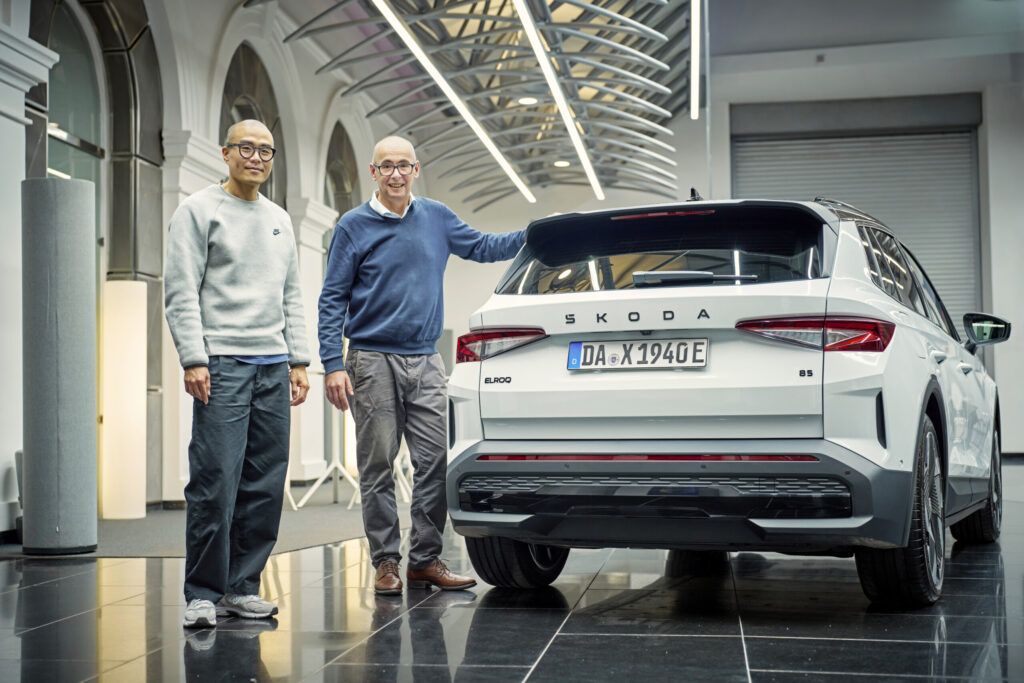Designing the look of a brand-new car is a dream job for many – often one that starts in childhood. But it’s also a demanding challenge. Designers must balance a range of sometimes conflicting demands. So how does the creative process really work, and what lies in the soul of a car designer? Karl Neuhold and Chan Park reveal more.
Karl Neuhold heads Škoda Auto’s exterior design team. He’s been working in Mladá Boleslav for 19 years, yet his energy is boundless. Chan Park, who became head of interior design in 2024, has more of a calm presence. But when the two start talking about their work, they’re unstoppable. Design is, quite simply, their passion.
Before they sit down for the interview, they look fondly at the white Elroq SUV prepped for a photo shoot. “The car is the star,” says Karl Neuhold explaining a key principle for every designer. It’s a reminder that while designers are often brimming with creativity and have a strong desire to push their ideas, they must not indulge in celebrity mannerisms. Ego must take a back seat because the goal is to create captivating cars that customer genuinely desire, not to push their personal ideas and wishes.
The essence of the car is behind the wheel
That’s also why real-world design is a long way from childhood fantasies of endlessly sketching cool sports cars — though that’s where Karl Neuhold himself began. “I was obsessed with cars as a kid. I started drawing them when I was about four. Matchbox models were a huge inspiration — I’d studied their proportions and just enjoyed their shapes,” he recalls.
But it’s not just the visual side of cars that excites him: “My dad started teaching me to drive when I was 11, and driving has stayed meditative for me ever since, even over very long distances!
As he speaks, Chan Park shows him photos of toy car models on his phone, and the two reflect on how they’ve evolved. Park’s journey into automotive design and aesthetics was much more pragmatic.
“During my studies, the internet was booming, smartphones were emerging, and everything was going digital. Industries were shifting — even camera makers were being disrupted. That got me thinking about my path, and I realized cars would always be relevant, because people will always need to move and travel,” he explains. “But sketching cars? That was probably the hardest thing I could’ve gotten into” he laughs.
Both designers agree that a car is far more than just a functional object. “If you dress really well, only fashion-minded people tend to notice, with a few exceptions. But when a beautiful vintage sports car drives by, everyone turns to look,” says Park. Neuhold adds, also emphasizing the emotional level “A car’s appearance can reveal what’s in your subconscious — who you want to be. People don’t want to drive an unsuccessful car from an unsuccessful brand.”
Designers: more than just artists
Designers are often seen as artists — automotive sculptors and painters. But the job demands much more. They must blend brand aesthetics, personal creativity, and a whole range of technical and market considerations.
“For me, nice proportions are key. The car has to sit right on the wheels — it’s hard to define, and even harder to achieve,” says Karl Neuhold, noting that sports cars make this a bit easier. “Today, when working on an exterior design, we also have to consider all the sensors and tech that modern cars include,” he adds.
Chan Park immediately follows up, “It’s perhaps even more intense here, in interior design. And remember, we design the car, which won´t hit the market and customers won’t see it until about three years later. Look at how fast technology is developing today, how AI is coming in, for example. Nobody knows what will be around in three years, but we have to create interiors that will still feel relevant and comfortable in that future.”
The first car
Karl Neuhold started his career in the Volkswagen Group at Audi Design. After work experiences at the Design Center Europe in Barcelona and VW Design in Wolfsburg he joined Škoda Auto as Head of Exterior Design in 2006, with his first project being the Joyster concept car. He also contributed to the first generation Superb Combi and led the design of the Yeti SUV (Showcar by Thomas Ingenlath) through to production.
Experienced designer Chan Park joined Škoda Design in June 2024. His first major design success came in 2008 with the Pininfarina Sintesi concept, for which he designed the four-seat interior.
Understanding what customers want is important — but you have to interpret it wisely. “When you ask people what they’d like, they often say they want something new and surprising. But when you try to give it to them, when you try it in practice, it doesn’t always work. Especially in Europe, people are actually quite conservative. That’s why our EVs still have a traditional-looking grille,” Park explains.
Neuhold picks up on this idea, “Our current Tech-Deck Face design references the grille from combustion-engine cars. It’s a transitional step. Customers still need to recognize a Škoda. That’s why we evolve things gradually — like replacing the logo with the Škoda wordmark recently.”
A fixed point amidst constant evolution
For all these reasons, designing cars is emotionally demanding. “We put our soul into the work — these cars are like our children. So, when something doesn’t go through, it feels personal. Some people are more sensitive than others, but at the end of the day, we all have to be professionals — and the team at Škoda Design definitely is,” says Park. Neuhold adds, “I’ve learned not to take it personally over the years, to take a step back from all of that, but I understand why others sometimes do.”
As team leaders, both work hard to keep everyone aligned toward the shared goal: a beautiful car created within the boundaries of technical feasibility. “Those boundaries keep shifting, because the car is a tech product that’s evolving fast. Just look at what headlights could do ten years ago compared to now,” says Neuhold.
Exterior and interior design go hand in hand. “Our collaboration is very natural — we don’t constantly consult each other, but we have a shared brief and strategy sorted out together with Oliver Stefani. We also present our designs together to company management, so we always know where things are going. We look and we see under each other´s hands.” Park explains.
Successful designers
Both designers are proud of and praise the work of the Škoda Auto design teams. “Even 19 years ago when I first joined, things worked really well here — great people, a great atmosphere, very homey in a way. That’s still true up till today,” says Neuhold, smiling. Why did he stay so long? “I was given a chance and I’ve always enjoyed it. What keeps me going is the positive energy,” he shares.
He’s especially happy that he’s spent his career focused on exterior design. “I tried interior design once, had a few ideas, so we gave it a go. But I just love the lines, the proportions — the ‘mass’ of the car,” he explains.
For Chan Park, his career path began with a lucky break. “My first job was at Pininfarina. The exterior of a major concept was already mostly set, but they were still searching for the right interior idea. So, I jumped in,” he recalls.
His fresh approach impressed the studio, and his design became part of the final concept. That led to his next opportunity — and his focus on interiors. “It wasn’t a plan, just a lucky moment. But I’m deeply passionate about this field,” he says of the turning point in his career.
He remembers another powerful moment from his early days: “Back when I was studying in London, I had to pay for everything myself. Markers and design supplies were expensive. Then, at my first job, my mentor opened a cabinet and said, ‘Take what you need, whenever you need it.’ That’s when it hit me — I’d made it.” Both men smile and add, “There are cabinets like that are waiting for new talents at Škoda Auto, too.”
Karl Neuhold heads Škoda Auto’s exterior design team. He’s been working in Mladá Boleslav for 19 years, yet his energy is boundless. Chan Park, who became head of interior design in 2024, has more of a calm presence. But when the two start talking about their work, they’re unstoppable. Design is, quite simply, their passion.
Before they sit down for the interview, they look fondly at the white Elroq SUV prepped for a photo shoot. “The car is the star,” says Karl Neuhold explaining a key principle for every designer. It’s a reminder that while designers are often brimming with creativity and have a strong desire to push their ideas, they must not indulge in celebrity mannerisms. Ego must take a back seat because the goal is to create captivating cars that customer genuinely desire, not to push their personal ideas and wishes.
The essence of the car is behind the wheel
That’s also why real-world design is a long way from childhood fantasies of endlessly sketching cool sports cars — though that’s where Karl Neuhold himself began. “I was obsessed with cars as a kid. I started drawing them when I was about four. Matchbox models were a huge inspiration — I’d studied their proportions and just enjoyed their shapes,” he recalls.
But it’s not just the visual side of cars that excites him: “My dad started teaching me to drive when I was 11, and driving has stayed meditative for me ever since, even over very long distances!
As he speaks, Chan Park shows him photos of toy car models on his phone, and the two reflect on how they’ve evolved. Park’s journey into automotive design and aesthetics was much more pragmatic.
“During my studies, the internet was booming, smartphones were emerging, and everything was going digital. Industries were shifting — even camera makers were being disrupted. That got me thinking about my path, and I realized cars would always be relevant, because people will always need to move and travel,” he explains. “But sketching cars? That was probably the hardest thing I could’ve gotten into” he laughs.
Both designers agree that a car is far more than just a functional object. “If you dress really well, only fashion-minded people tend to notice, with a few exceptions. But when a beautiful vintage sports car drives by, everyone turns to look,” says Park. Neuhold adds, also emphasizing the emotional level “A car’s appearance can reveal what’s in your subconscious — who you want to be. People don’t want to drive an unsuccessful car from an unsuccessful brand.”
Designers: more than just artists
Designers are often seen as artists — automotive sculptors and painters. But the job demands much more. They must blend brand aesthetics, personal creativity, and a whole range of technical and market considerations.
“For me, nice proportions are key. The car has to sit right on the wheels — it’s hard to define, and even harder to achieve,” says Karl Neuhold, noting that sports cars make this a bit easier. “Today, when working on an exterior design, we also have to consider all the sensors and tech that modern cars include,” he adds.
Chan Park immediately follows up, “It’s perhaps even more intense here, in interior design. And remember, we design the car, which won´t hit the market and customers won’t see it until about three years later. Look at how fast technology is developing today, how AI is coming in, for example. Nobody knows what will be around in three years, but we have to create interiors that will still feel relevant and comfortable in that future.”
The first car
Karl Neuhold started his career in the Volkswagen Group at Audi Design. After work experiences at the Design Center Europe in Barcelona and VW Design in Wolfsburg he joined Škoda Auto as Head of Exterior Design in 2006, with his first project being the Joyster concept car. He also contributed to the first generation Superb Combi and led the design of the Yeti SUV (Showcar by Thomas Ingenlath) through to production.
Experienced designer Chan Park joined Škoda Design in June 2024. His first major design success came in 2008 with the Pininfarina Sintesi concept, for which he designed the four-seat interior.
Understanding what customers want is important — but you have to interpret it wisely. “When you ask people what they’d like, they often say they want something new and surprising. But when you try to give it to them, when you try it in practice, it doesn’t always work. Especially in Europe, people are actually quite conservative. That’s why our EVs still have a traditional-looking grille,” Park explains.
Neuhold picks up on this idea, “Our current Tech-Deck Face design references the grille from combustion-engine cars. It’s a transitional step. Customers still need to recognize a Škoda. That’s why we evolve things gradually — like replacing the logo with the Škoda wordmark recently.”
A fixed point amidst constant evolution
For all these reasons, designing cars is emotionally demanding. “We put our soul into the work — these cars are like our children. So, when something doesn’t go through, it feels personal. Some people are more sensitive than others, but at the end of the day, we all have to be professionals — and the team at Škoda Design definitely is,” says Park. Neuhold adds, “I’ve learned not to take it personally over the years, to take a step back from all of that, but I understand why others sometimes do.”
As team leaders, both work hard to keep everyone aligned toward the shared goal: a beautiful car created within the boundaries of technical feasibility. “Those boundaries keep shifting, because the car is a tech product that’s evolving fast. Just look at what headlights could do ten years ago compared to now,” says Neuhold.
Exterior and interior design go hand in hand. “Our collaboration is very natural — we don’t constantly consult each other, but we have a shared brief and strategy sorted out together with Oliver Stefani. We also present our designs together to company management, so we always know where things are going. We look and we see under each other´s hands.” Park explains.
Successful designers
Both designers are proud of and praise the work of the Škoda Auto design teams. “Even 19 years ago when I first joined, things worked really well here — great people, a great atmosphere, very homey in a way. That’s still true up till today,” says Neuhold, smiling. Why did he stay so long? “I was given a chance and I’ve always enjoyed it. What keeps me going is the positive energy,” he shares.
He’s especially happy that he’s spent his career focused on exterior design. “I tried interior design once, had a few ideas, so we gave it a go. But I just love the lines, the proportions — the ‘mass’ of the car,” he explains.
For Chan Park, his career path began with a lucky break. “My first job was at Pininfarina. The exterior of a major concept was already mostly set, but they were still searching for the right interior idea. So, I jumped in,” he recalls.
His fresh approach impressed the studio, and his design became part of the final concept. That led to his next opportunity — and his focus on interiors. “It wasn’t a plan, just a lucky moment. But I’m deeply passionate about this field,” he says of the turning point in his career.
He remembers another powerful moment from his early days: “Back when I was studying in London, I had to pay for everything myself. Markers and design supplies were expensive. Then, at my first job, my mentor opened a cabinet and said, ‘Take what you need, whenever you need it.’ That’s when it hit me — I’d made it.” Both men smile and add, “There are cabinets like that are waiting for new talents at Škoda Auto, too.”










